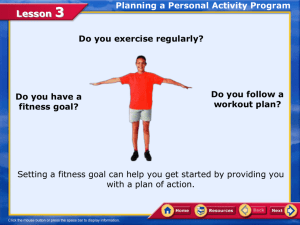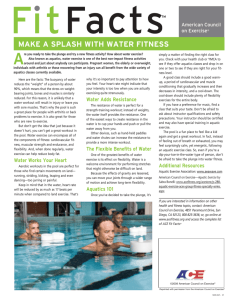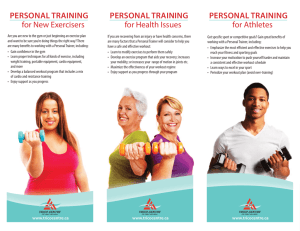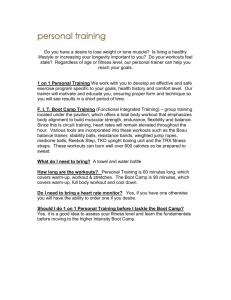Chapter 4 Lesson 3 Planning a Personal Activity Program
advertisement
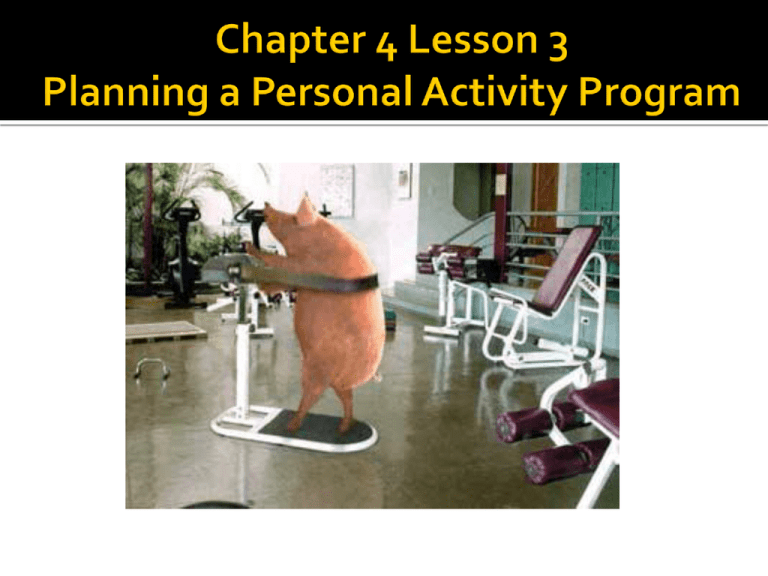
By the end of this lesson you will be able to: Set realistic fitness goals Synthesize information & apply critical-thinking, decision-making, & problem-solving skills to develop a personal physical activity program. Identify the basic principles of a physical activity program. The first step is to set realistic goals. Teens should get 60 minutes of physical activity a day. This can include physical education classes, playing sports, doing household tasks. Your school or community may offer programs that provide a variety of fun and healthful physical activities. Including different types of physical activity in your fitness program can help make it more enjoyable Cost – some activities require specialized and expensive equipment. Where you live – you will want to do activities you can do locally without a lot of travel time. Your level of health – some health conditions have risks that need to be considered when planning physical activities. Time and Place – build your program into your daily routine. Personal Safety – Avoid exercising in unsafe or hazardous areas. Comprehensive Planning – select activities that will address all 5 areas of health-related fitness. The effectiveness of a program is based on three principles: Overload – working the body harder then it is normally worked. Progression – the gradual increase in overload necessary to achieve higher levels of fitness. Specificity –indicates that particular exercises and activities improve particular areas of health-related fitness. Cross Training – engaging in a variety of physical activities to strengthen different muscle groups. To gain the most from an exercise program you will want to include three basic steps for each activity. 1. Warm-Up 2. Workout 3. Cool-Down Warm-up – an activity that prepares the muscles for work, is the first stage in any physical activity routine. Raises you body temperature. Stretch large muscle groups to increase elasticity and reduce risk of injury. Allows pulse rate to increase gradually. A sudden increase places unnecessary strain on the heart and blood vessels. Workout – part of the exercise program when the activity is performed at its highest peak . To be effective, the activity needs to follow the F.I.T.T. formula. Frequency – how often you do the activity each week. You should workout at least 3-4 days a week with no more than 2 days between workouts. Intensity – how hard you workout. Begin slowly to build endurance. You need to reach overload to have gains in fitness. Time/Duration – how much time you devote to a session. Aerobic workouts should last for at least 20 – 30 minutes. Weight training for be longer with 1 –2 minutes between sets. Type – which activities you select. For maximum health benefits devote 75-80% of the workout to aerobic activities and 20-25% to anaerobic activities. Choose activities that you enjoy or you may find it difficult to complete workouts. Cool-Down – an activity that prepares the muscles to return to a resting state. Begin by slowing down activity and stretching for 5 minutes. Resting Heart Rate – the number of times your heart beats in one minute when you are not active. This can be used to monitor your progress. Average RHR is between 72 and 84 beats per minute. As you become more physically fit, your RHR will decrease. Try to have a RHR below 72. How can the Physical Activity Pyramid help you meet your fitness goals? Identify & define the three principles upon which all effective fitness programs are based. What do the letters in the F.I.T.T formula stand for? How is your resting heart rate an indication of your level of fitness?


